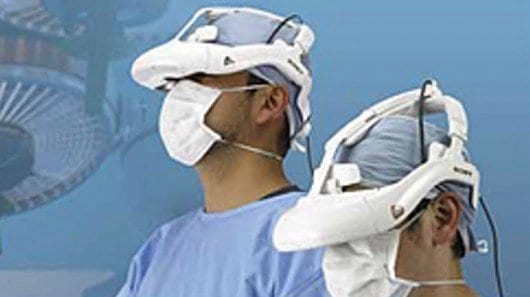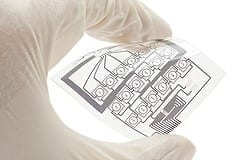
This setup allows surgeons to view high definition 3D images from inside the patient while carrying out laparoscopic surgery.
Having introduced its HMZ-T1 personal 3D viewer aimed at the home entertainment market in 2011, and updating it in 2012 with the HMZ-T2, Sony has ventured into the operating theater for its latest head-mounted display. Unveiled last week in Tokyo, the “head-mount image processing unit” gives surgeons virtual X-ray vision by means of an endoscope feeding images to a pair of head-mounted monitors. This setup allows surgeons to view high definition 3D images from inside the patient while carrying out laparoscopic surgery.
Also known as “keyhole“ surgery, laparoscopic surgery is a less invasive alternative to more conventional procedures, which often involve slicing the patient open with a large incision. This is not only to allow the surgeon to reach in and work, but also to see what they’re doing. The problem is that a foot-long incision is in itself a traumatic thing for the body to deal with.
In contrast, laparoscopic surgery only requires small incisions through which long probes equipped with grabbers, cutters and endoscopes are inserted. This approach is not only less invasive, but there’s also less chance of infection, less stress on the patient, and the incisions heal faster. Gallbladder removal, for example, which once required a large incision and a long stay in hospital can now be done with a couple of small incisions and a brief hospital stay.
One of the drawbacks of the technique is figuring out how to get a clear view of what’s going on. Usually, this involves the insertion of not only special tools into multiple incisions, but also endoscopes hooked up to television monitors that provide a flat image. Taken together, it’s almost like doing surgery by remote control. In recent years, 3D imaging systems have improved things, but there’s still room for improvement.
Sony’s answer is a head-mounted image processor with a 3D monitor that connects to a surgical laparoscope. The headset consists of a pair of 0.7-inch (18.0 mm diagonal) organic light-emitting diode (OLED) panels. According to Sony, these produce high-resolution (1280 x 720) stereoscopic images with precise reproduction of colors and blacks. Separate images are produced for each eye to prevent crosstalk. The headset is also compatible with 2D output from the endoscope, with the wearer able to switch between 3D and 2D views by selecting the “input” button on the image processing unit.
The Latest Bing News on:
3D video display
- Swave Photonics develops true holographic display for spatial computingon April 25, 2024 at 1:00 pm
Swave Photonics, a "true holographic display" company, announced the world’s first 3D holographic display technology for XR.
- Swave Photonics debuts Holographic eXtended Reality display with tiny-pixel technologyon April 25, 2024 at 6:00 am
Holographic display startup Swave Photonics today announced the development of what is claimed to be the world’s first 3D holographic display technology for compact extended reality form factors such ...
- Blackmagic launches SmartView 4K G3 display + answers my 4 questionson April 24, 2024 at 9:42 am
Blackmagic released its new 15.6 inch diagonal SmartView 4K G3 display (U$1265), which is the first of the series to support SMPTE‑2110. See my recent article Blackmagic democratizes SMPTE 2110 with ...
- Unraveling the Tale of the First 3D Animation on YouTube? [Video]on April 23, 2024 at 10:51 am
While most rave about the marvels of contemporary 3D animation, few recall the breakthrough that started it all. Nestled within ...
- How to turn off Google Maps 3D buildings on Android Auto and CarPlayon April 20, 2024 at 10:15 am
turning off 3D buildings in Google Maps is rather easy. Opening up Maps in fullscreen on your car’s display will reveal a settings shortcut and, as you scroll down the page, a toggle will appear ...
- Formlabs Launches Form 4, The Fastest, Most Reliable 3D Printer for Prototyping through Productionon April 17, 2024 at 7:31 pm
The new resin 3D printer by Formlabs- Form 4 Ecosystem. Produce parts at blazing speed, incredible precision and unmatched accuracy (Photo: Business Wire) "Form 4 marks a significant advancement for ...
- Firearms cheaply made on 3D printers, guns pouring into NJ from Pa; lawmakers seek solutionson April 16, 2024 at 3:17 pm
Lawmakers in New Jersey say something needs to be done about illegal guns in the Garden State. Many of the guns are being printed at home on 3D printers, while others are flowing from Pennsylvania.
- NAB 2024: New Neoti dvLED Display Is Pantone Validatedon April 16, 2024 at 7:00 am
On Sunday, during 2024 NAB Show in Las Vegas, Neoti announced that its new UHD Pro XF+ is the world’s first dvLED display to be named Pantone Validated and Pantone SkinTone Validated.
- Best 3D modeling software of 2024on April 16, 2024 at 6:06 am
Generally, the best laptops for video editing or the best video editing PCs should be able to easily handle most 3D modeling software. How to choose the best 3D modeling software When choosing ...
- Apple uses a unique method to stream and present immersive videoon April 15, 2024 at 8:38 am
Apple's take on immersive video for the Apple Vision Pro is a departure from typical fisheye projections, incorporating an interesting twist for the high-resolution headset.
The Latest Google Headlines on:
3D video display
[google_news title=”” keyword=”3D video display” num_posts=”10″ blurb_length=”0″ show_thumb=”left”]
The Latest Bing News on:
Head-mount image processing unit
- Review: On-board unit for ERP 2.0 – the good, the bad and the uglyon April 19, 2024 at 11:41 am
The owner will decide with the technician where to mount the processing unit ... on a BMW X2 because the Toyota’s radio-cassette head unit does not have app-projection capability.
- Fraunhofer IOF researchers develop goSCOUT3D handheld scanneron April 15, 2024 at 11:13 am
Researchers from the department of Imaging and Sensing at Fraunhofer IOF have addressed this problem from the shop floor and searched for a way to make the measurements more comfortable for humans, ...
- The Best VR Headsets for 2024on April 14, 2024 at 5:00 pm
As a first-generation device on a newly launched platform, VisionOS, it's surprisingly full-featured, with some of the best hardware ever put into a consumer-available, head-mounted display.
- Roku's first Mini LED TV is available now, and it includes a feature that takes Samsung's The Frame head-onon April 11, 2024 at 7:48 am
Roku advertises this as a QLED TV, with a Mini LED backlight and, presumably, quantum dots which should make for enhanced colour volume. It also features Roku Smart Picture Max which Roku claims will ...
- Lightweight, head-mounted microscope unveils brain oxygenation in freely moving miceon April 1, 2024 at 5:00 pm
B. O. Guan and colleagues have introduced an innovative head-mounted microscope. This cutting-edge device enables continuous imaging of oxygenation in mice without restricting their movement.
- Health Concerns Mount for Migrant Children at Outdoor Waiting Siteson March 27, 2024 at 5:01 pm
Image Families who had traveled from Ecuador and El Salvador waited at a makeshift camp in the California desert to be picked up by U.S. Border Patrol for ... in deep head gashes, and local ...
- The Definitive Guide to Choosing the Best Digital Camerason December 20, 2023 at 5:50 pm
The camera’s focus and speed make it easy to track subjects with 1,053 Automatic AF zones, including Eye, Face, and Head Detection AF for people and Animal Detection AF for cats, dogs, or birds. The 5 ...
- How To Use Any Android Tablet As An Android Auto Car Head Uniton April 2, 2023 at 9:20 pm
Android Auto allows you to connect your phone to your car’s system and control apps like Maps and Music using the built-in touchscreen head unit ... Before you mount the tablet, you must ...
- Why There’s New Hope About Ending Blindnesson September 5, 2021 at 7:01 am
They would jiggle and jerk and roll up into his head. One eye turned ... signals from a tiny eyeglass-mounted camera that relays them through a processing unit carried on a belt or in a bag.
- The CNN 10: Inventionson August 14, 2020 at 12:00 am
It contains an antenna and some electronics, and connects to an exterior system consisting of eyeglasses, a video processing unit (VPU ... Rift is a head-mounted, virtual-reality device designed ...
The Latest Google Headlines on:
Head-mount image processing unit
[google_news title=”” keyword=”head-mount image processing unit” num_posts=”10″ blurb_length=”0″ show_thumb=”left”]









